December 21, 2011: A plethora of Petersens
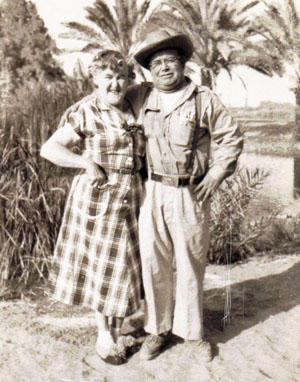
At least two sides of my Petersens have been exploding (in a nice way) with new information, and it all comes from posting something on the web and waiting for cousins to come calling.
First it was a descendant of my grandfather's sister Marie, and a couple months later the granddaughter of these jolly folks. Both provided me with a plethora of new family information and photos.
Clarence and Dora Petersen had been a particular stumbling block. An elderly cousin in Chicago remembered him vaguely, mainly as the uncle who used to ride a loud motorcycle and scare all the kids on the block with its roar. Clarence disappeared to Arizona, as she remembered it, and wasn't heard from again.
She was mostly right. Clarence's granddaughter set me straight on most of the family after he and his wife Dora left Chicago. For awhile they ran a lodge in Palo Verde, Arizona, and eventually Clarence's love of mechanics led him and his family to Date City, California, east of El Centro in the desert. There Clarence and Dora ran a motel, a general store, and a gas station. His granddaughter remembers riding in Clarence's truck and visiting the store, which sold everything from cowboy shirts to canned goods. By all accounts Clarence and Dora lived a happy life in their little corner of California.
Whether or not Clarence knew that his two brothers were living in California too is something no one knows. Alva (born Alfred) was in the Los Angeles area, while brother George was in Yolo County near Sacramento. Did they come west to get lost from relatives back in Chicago? If so, it only worked for half a century!
Show comments/Hide commentsComments
Write A Comment
October 10, 2011: The fruits of private archives
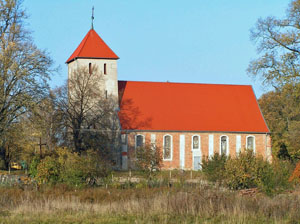
Here's a little country church that I'd never have seen without a chance Internet connection.
A couple weeks ago I received an email from someone working on records in Nippoglense, a town now in Poland but which was in Pomerania when my great-grandfather was born there. Polish records are notoriously difficult to access today, usually requiring expensive archival fees and months (if not years) of delays. As a result I'd pretty much dismissed ever obtaining any data on Wilhelm Gohr or his parents.
This researcher had done an online search for Nippoglense, looking for some of his own ancestors, and the web in its wisdom brought him to one of my web pages (keywords are such fun). So he dropped me an email and I'm glad that he did. My new friend generously offered to do some look-ups for me, resulting in the names of Wilhelm's parents and his many siblings. He even took a photo of the church (Lutheran in Wilhelm's time, Catholic now) where all the baptisms were registered. Without this fellow's kind offer I'd never have known anything about Wilhelm's life in the old country. As it is, now I can see from the naming patterns of Wilhelm's children in Chicago why they were given those names -- to honor those who never reached the new world.
There were no Gohrs left in Nippoglense after the early 20th century, and from what I can tell only one of Wilhelm's siblings came to Chicago. That leaves more Gohrs to track down one day, somewhere other than Nippoglense.
Show comments/Hide commentsComments
-
I wish these sorts of things happened to me! I have family on my mother's side that came from Nippoglense but I can't find anything out about them. Is hiring a researcher expensive?
Write A Comment
September 30, 2011: Learning to read like a genealogist
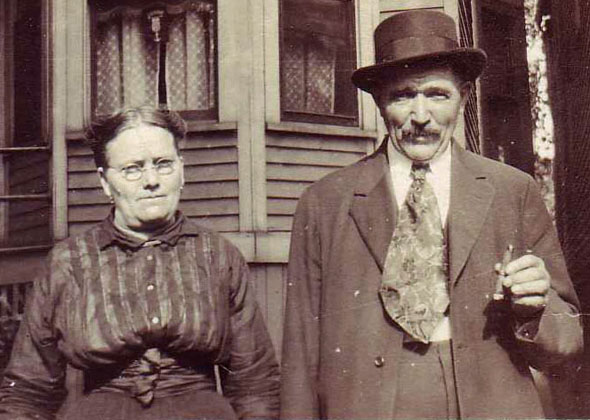
Over the past five years I've spent a passel of time looking for this handsome fellow in the land that was alleged to be his home, Denmark.
I ignored two essential principles of research: (1) work from what your know and (2) pay attention to what your ancestor said about himself, not what his children said, even when they seem to be very sure.
Thomas Mikkelsen was my step-great-grandfather. He married the widowed Catherine Petersen (my great-grandmother) in 1906 in Chicago. I know where Catherine was born: Leck in northern Schleswig-Holstein.
But Thomas' children from his first wife knew all about him and recorded his birthplace as Middelfart in Odense, Denmark. I suppose my main mistake was to believe them. Not only that, but I'd been told that as grown-ups they argued incessantly over whether they were Danish or German. Why such fervor? If Thomas was born in Denmark, no argument needed.
Except, of course, even with such a precise birthdate and place, I'd never been able to find Thomas anywhere in Denmark.
So I bit the bullet and ordered his daughter's Chicago death certificate. According to her family she was supposed to have been born in Denmark too. Guess what? She was born in Ladelund, a town in northern Schleswig -- admittedly close to the Danish border but not, in 1876, part of Denmark. But the town was about 20 kilometers from Flensburg, her mother's birthplace, and about ten kilometers from Leck, where Catherine Petersen Mikkelsen was born.
If both his wives were from Schleswig, was Thomas born there too?
I went back to Thomas' census records in Chicago, the only town he lived in after his 1887 emigration. How many times had I looked at them? Over how many years? I'd have to admit that I never paid attention to his country of origin, which either he or his wife would have reported to the enumerator. It was Germany, not Denmark. At least that's a start.
So let the first family (or their descendants) argue about it all they want. To find Thomas, I'm going to remind myself how to pay attention to what's there right in front of my eyes.
Show comments/Hide commentsComments
-
No comments yet.
Write A Comment
September 23, 2011: The adorable couple
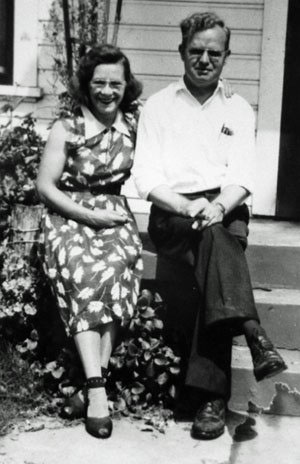
This is about as happy as my grandparents ever looked, at least on film. But things were looking good. It was a sunny Chicago day, their son was home from the war, and the family was contemplating a move to a warmer climate. Perhaps an escape from the past was also a motivating factor.
They almost succeeded in leaving no clues about their ancestral roots. But there was still too much left behind in city vaults and record rooms, where clerks were required to note pesky details of marriages almost made, true civil unions, countings of family members, their incomes, their ages, their professions.
Their motives may have been mostly innocent. So many like them embraced the virtues of the here-and-now. Progress is an American dream. Focusing on the past was so quaint and European. The right name, the right set of skills, drafting pencils in your pocket and a nice cigar. With those accoutrements you and your family could go as far as you chose to go. Just a few bits from family remained, unexplained and unannotated: a gold pocket watch and a cameo. Well, a boy always has his father's watch. Was the cameo his mother's?
Another curiosity: no family photo album from these two was ever found. Her past was no more visible than his, though one can understand why. A clearly German surname was a liability during one world war. But she was a Southerner and thoroughly American, her father an American born in the south too, a boy in a German community whose childhood passed through the War Between the States, who thrived and married a minister's daughter, was set up nicely in his grandfather's and uncle's mercantile business. And then her father died not long after the turn of the century.
She and her sister, artistic and passionate, with their more prosaic brothers were whisked to Chicago in 1910 under a shroud of mystery, perhaps something to do with the child her sister had a year later. There my future grandmother met the man who convinced her to elope at age thirteen. Her borrowed older sister's papers convinced the clerk to issue the license but not the judge to perform the marriage. A longer, if unhappier, union followed two years later, with her mother the minister's daughter signing her consent. Here, several decades removed from bride and groom, the couple look as though they'd learned to live with each other.
When I was at the start of my research, I remember thinking that I'd be happy just to know the names of their parents. Seven years ago I started searching with the kind aid and encouragement of friends and family. Now we know a few things about them. He descends from Hans Schmid the blacksmith, born about 1653 in Arrild, Denmark. She from a schoolmaster called Valentin Jatho, born about 1620 near Dransfeld in Germany. My grandfather's ancestors used patronymics, changing every generation until the early 1800. So maybe it's no surprise that he too changed his own surname in the twentieth century.
Ironically, my grandmother's surname was the same as the man born almost three hundred years earlier. Neither of them knew the real story of their roots.
But now I do. And I'm grateful to everyone who has made it possible to know more.
Show comments/Hide commentsComments
-
No comments yet.
Write A Comment
September 15, 2011: New cousins
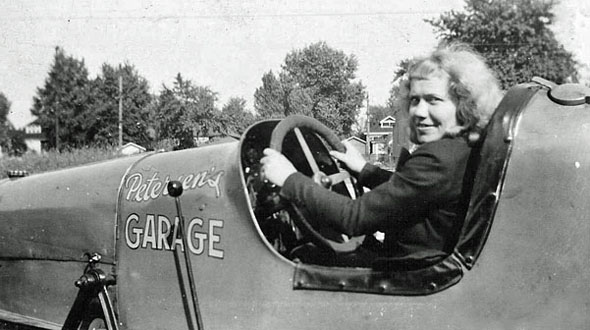
Sometimes all you need to do is add searchable content to the web, sit back, and wait for action.
My "Contact" button doesn't get a hit too often, but when it does the results are usually worthwhile. Not so long ago someone doing a search for this lady's name, plus her birth year, brought her to my genealogy web page. I knew this cousin was out there, I just didn't know when she'd drop by. But I hoped that eventually a natural curiosity about ancestry would bring us together.
And now we have another view of a Petersen who's been a mystery. Marie was my grandfather's younger sister, who it appears also inherited the family predilection for automobiles. Her brothers George and Clarence probably owned the garage referred to on the car. I had no idea there'd been a business like this, but it makes sense.
More facts to tuck away from a family who (so it seems) were all reluctant to talk about their past. We're doing our best to unearth their secrets.
Show comments/Hide commentsComments
-
No comments yet.
Write A Comment
September 2, 2011: Mystery in the Müller plot
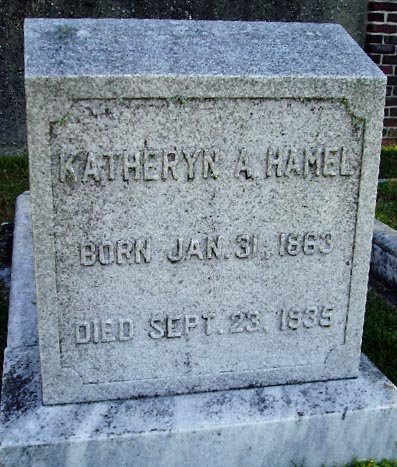
When we were in Charleston, South Carolina a few years ago we visited Bethany Cemetery, where a good number of my ancestors were buried, mainly German immigrants and their offspring.
My great-great-grandfather was Ludwig Müller, pastor at St. Matthew's Lutheran Church for fifty (count 'em!) years, so it must have seemed the right thing to do: make sure the family plot is big enough for anyone who wants to be included.
But who was Katheryn Hamel?
No clue on the headstone, no Hamels in my genealogy database...but here she is, nestled next to the Rev. Müller (who died in 1898) and his wife Caroline Laurent (who died in 1910).
My husband, with characteristic foresight, suggested that we take a photo of the headstone anyway, just in case somewhere down the line Katheryn popped up (in a manner of speaking).
So we did. Until yesterday she remained an enigma.
The nice thing about time marching on is that new collections become available online, and ancestry.com has recently released some delayed births, marriages, and death records for South Carolina. I've been having more fun with these records than you might think possible. Wonder of wonders: Katheryn's death certificate is part of the collection, and here's who her parents are:
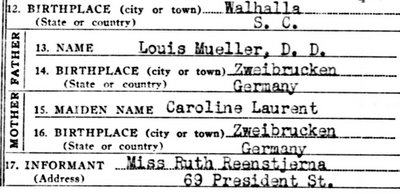
Now it makes sense why she's buried in the Müller plot. Katheryn was actually their penultimate daughter, who I've seen in the St. Matthew's church records as Adeline Catherina Fredericke Müller, the way she was baptized. As was so often the custom, in Germany as well as in American German communities, children often chose their second name as their preferred everyday one.
I'd been unable to find her because I assumed (and should have known better) that she would be found as Adeline Müller. I also assumed that she would have married and her married name would be forever unknown to me. Patience has its own rewards.
I haven't been able to find out anything about Katheryn's husband, listed as Herman Hamel on the death certificate. The informant, Ruth Reenstjerna, was a niece. This suggests to me that Katheryn and Herman had no offspring of their own. There's more work to be done, but it's nice to have the mystery lady identified at last.
Show comments/Hide commentsComments
-
That's a good reminder for me too. Thanks for your nice blog, I enjoy your discoveries.
Write A Comment
August 26, 2011: Old country, new country
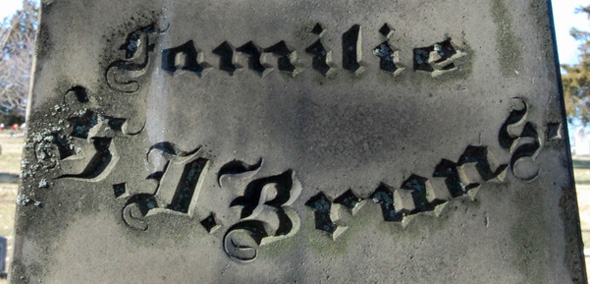
Cincinnati is one of the towns where my ancestors settled...two different families, in fact, found it accommodating, catering as it did to recent German immigrants in the 1840s. There were churches and businesses where discourse was entirely in German, and a friendly local newspaper in the same familiar language.
Heinrich Joseph Bruns was the more prosperous of the two patriarchs, working as a teamster (in the old sense, driving a team of horses for a local dairy). He was even able to purchase a nice plot at St. Joseph's Cemetery just to the west of town for his voluminous family.
We visited the site several years ago on a warm December day and were stunned to see the nice stone obelisk marking the plot, carved with his name in elaborate Gothic script. Joseph (as he preferred to call himself) managed to fit sons, daughters, his wife Elizabeth, as well as various in-laws and infants of same all in the cozy, southern-facing hill. I don't think that he and the family have had many visitors recently, but it was nice to see him all the same.
Some Bruns relatives who were left behind in Oldenburg didn't have it quite so well. A German cousin sent some documents that illuminate hard times in the little villages around Hohenbögen, where Joseph's uncle and aunt remained. It sounds like a soap opera: the uncle died, the aunt became an alcoholic, the children had to sell the farm, the sons got all the property, and the daughter who should have had a good dowry for her marriage was left with nothing.
It took three generations for the Brunses of Hohenbögen to hobble back to something resembling prosperity. Perhaps they wished that they too had gone to the New World like Heinrich Joseph!
Show comments/Hide commentsComments
-
No comments yet.
Write A Comment
August 20, 2011: That's the way the brick wall crumbles
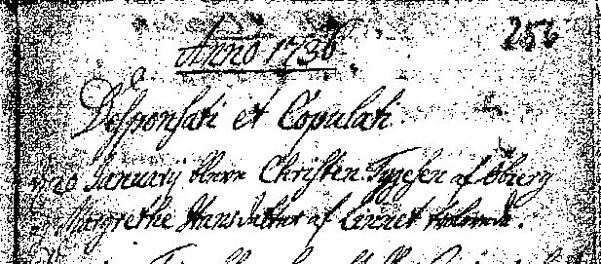
Another day, another few kroner in one's pocket, and on January 20, 1736 Christian Tygesen of Objerg was betrothed to Margrethe Hansdatter of Linnet (later Øster Lindet). What became of them? Something worth a closer look, I think.
I've been trying to poke through a persistent brick wall (i.e. back from Peder Hansen, my earliest confirmed Danish ancestor, who was born in 1774) and may have found something of interest. At the moment I can't prove it. But it's looking like a hopeful lead.
Finding his father's name has not been easy. It wasn't mentioned in his marriage record, which is a cryptic, one-sentence entry in the Hostrup church book. It was also in Hostrup where practically everything requiring a church ceremony was done: Peder's marriage to Barbara Sørensdatter in 1799, the birth of their two boys in 1799 and 1806, and now, it seems, their deaths.
I found Barbara's easily in 1844. It only recently occurred to me to check there for Peder as well...and there's a possible candidate in February 1828. But the right-hand side of the page is missing, and this would have contained his age (so we could verify that he's the right one), his wife's name, his birthdate and place, maybe even parents' names.
Some church parishes had two sets of books kept in case one was destroyed, so I'm trying to find out whether Hostrup followed this practice and whether the alternate church book is still available (both the online Danish archive and the microfilm use the same source and both have the missing page). Finding the duplicate book might only happen via a hired researcher in Denmark. And then again, it might never happen at all.
But there's a clue back in Haderslev, the county where Peder was born (as we know from his marriage record). I found a confirmation for an eighteen-year-old Peder Hansen in 1792 and his brother Hans Hansen in the town of Øster Lindet. That's promising!
It's the same town where the 1801 Danish census shows 25-year old Peder (thus born in 1774 or 1775) with wife Barbara and baby son Hans. The confirmation record fits my Peder's age. And this record gives us the name of the confirmation boys' father, Hans Christian Christiansen.
This is good so far---Peder's father has to have the first name Hans, and finding the confirmation in the town where Peder later lived is another bit of luck. Better yet, I looked up Hans Christian Christiansen in the 1801 census. He also lived in Øster Lindet and his profession (like my Peder) was a tailor.
Not conclusive, but having father and son share the same profession and live in the same town suggests a strong possibility that they're related. So does the fact that I can find no other Peder Hansens of the right age living in Øster Lindet or any of the other small towns in the region.
So I still need some documented verification that ties Peder absolutely to this father (I'm waiting for microfilms containing probate and military rolls for these regions, hoping that there might be some further clues). Nevertheless, from just the name Hans Christian Christiansen, I can work backward three more generations from Peder Hansen. If verifiable, this puts our Danish line back as far as 1678.
This probable ancestor was Tÿgge or Tycho (spelled both ways) Jacobsen or Jörgensen. It would be nice to know for certain whether this is one man or two, and I'm still working through the barely-readable images to figure that out.
Tÿgge and Tycho are both the same first name, just spelled differently, and there seems to be only one person using this first name in the town of Objerg, where the records trace him. Objerg was in the county of Tønder, one county south of Haderslev. There are two records that show him as Jacobsen and one as Jörgensen---a priest's typo, perhaps (such things did happen), or perhaps a different person entirely. More scrutiny should help me figure this out.
The records do show without a doubt that Tÿgge had a son called Christian Tygesen, and that Christian had a son called Hans Christian Christiansen. We need better proof that this Hans is the father of our Peder, but I'm leaning in that direction.
It feels precarious doing research this way, relying on probables rather than absolutes, and I don't like to do it if there are other options. But at the moment, other options are scarce, and this is the best I can do for now.
Show comments/Hide commentsComments
-
No comments yet.
Write A Comment
August 9, 2011: Celebrities in the tree
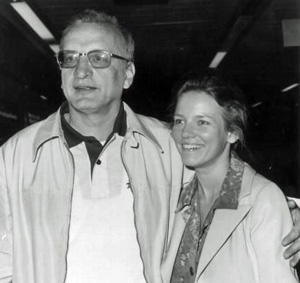
Who would have thought?
Not me, of course. But a couple weeks ago I got an email out of the blue from someone searching the surname Dressel.
We have a few of those, of course, so far documented to about 1700 in Hesse-Darmstadt, and this fellow doing the search encountered our Dressel web page. So he emailed me to share some new information.
He's related to our Marie Dressel Schuckmann, but more directly to her younger brother Hermann. One of Hermann's sons was Frederick Dressel, the esteemed 19th-century botanist and orchid hybridizer in New Jersey.
And among Frederick's descendants is Patricia Louise Dressel, more famously known as the actress Trish Van Devere, wife of the late actor George C. Scott. The California marriage index, available via ancestry.com, shows that they were married in Los Angeles in 1972. Trish used her birth name Patricia Dressel in the official record.
If Trish Van Devere is interested in her genealogical background and comes across this message, she'd be most welcome to email me. It's a pleasure to add these two luminaries into our database.
Show comments/Hide commentsComments
-
No comments yet.
Write A Comment
July 31, 2011: Harvest time
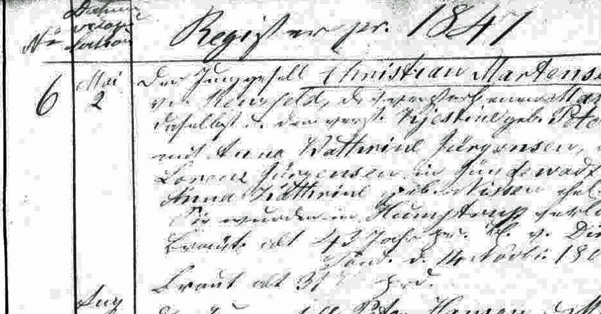
They say, when you start out in genealogy, "welcome to the addiction", but they don't tell you that's what really happens.
It also accelerates over time. Not to say you need new and better drugs, just new and better sources. Name-harvesting from other people's trees really isn't the goal (in fact it's a very bad one, especially if their own research lacks good source work).
A nice fellow in Denmark has a service called Gedcomp. He compares submitted gedcom files from hundreds of folks and runs a computer program to compare data. If there's a match, he'll email you and tell you. He found one person who matches our Katherine Jürgensen in Jundewadt. Her marriage to Christian Martensen from 1847 is above.
Katherine was my great-great-great-grandmother Ellen's younger sister. Whoever this fellow is in Denmark has her listed in his files too, though he doesn't seem to know about her siblings or parents, and he lists no descendants for her.
Is he our cousin? Well, if he knows for sure that he descends from her line in some way, there's a chance. But the fact that she and her husband are listed on a spur line suggests that he may have been gathering names for the fun of it...not that there's anything wrong with fun. His gedcom contains 200,000+ names, considerably more than the modest 1,300+ we have in our database. Perhaps he's been combining families from other sources, the better to build a robust file of folks.
However, robustness of one's database does not necessarily result in an accurate collection of names. I didn't add in Katherine or her siblings into our database until I was sure about how she and Christian fit into our familial constellation. Maybe this fellow has proof, for all I know, and that would be good. But his gedcom doesn't demonstrate it, so far. Perhaps, when I get in touch with him, we might discover what's what...or what's not.
Show comments/Hide commentsComments
-
No comments yet.
Write A Comment
July 23, 2011: Brotherhood defined
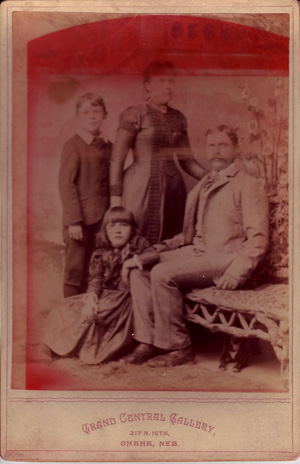
You'd think a family with so many naming options could come up with a more original name than Peter Hansen Petersen...but you'd be wrong.
There was the father, Peter Hansen Petersen, born in 1822 just on the southern edge of Denmark. Then his son Peter Edlef, born in 1857 across the border in Schleswig-Holstein. And to follow up, another son, Peter Hansen, born in 1860 in the same little town. One can only wonder how they kept track of themselves at home.
The plethora of Peter Petersens wasn't limited to my family alone. In fact, their ubiquity made it that much more difficult to find the man and his family (in the poorly preserved cabinet card above) in Nebraska, where I knew they had likely settled in the 1880s. How do you find the right one?
The hunt was complicated by the fact that folks in this branch of the family thought nothing of changing their names whenever the whim persuaded them to do it. Peter Edlef Petersen became Alfred Petersen in this country, which made locating him a real treat. But finding Alfred was the first clue that not all the Petersen siblings fled Nebraska as a sister (Catherine) and brother (Andrew) did in the 1890s. Maybe others stayed near Omaha as well.
It proved to be true. Peter Hansen Petersen's younger brother Louis remained in Omaha as well, working as a saloon-keeper until Prohibition, then transforming himself as a confectioner. Alfred worked in farming just outside Omaha as well. It seemed likely that Peter Hansen stayed close...but where?
You've got to know how these brothers defined themselves in the census records to do a successful search for them. Most of them remembered (within one or two years) what year they emigrated: 1878, so that's one clue. All identified themselves as natives of Germany, which had jurisdiction over Schleswig-Holstein, which is helpful too, since most Petersens are listed as Danish. Worth noting: all these Petersen siblings change their nationality to Danish in 1920, which considering anti-German sentiment after World War I was a sensible thing to do.
Looking for someone of the right age in or near Omaha with the right set of circumstances brought me to Custer County, not too far from Omaha, and as luck would have it, the Custer County Historical Society had an obituary for a lady who was married to a Peter H. Petersen. The 1910-1930 censuses all had a likely candidate as well, just the right age, emigration year, the whole shebang. So I wrote to the nice folks requesting a copy of the obit (they appreciated the small donation I sent too, evidently this helped to fill them with enthusiasm for the task).
Alas, the obit showed that the lady was not married to my Peter H. Petersen, but by a stroke of good luck (that's all you can call it) my guy did live in the same county, and they found his obit and one for his Mrs. as well. Very kind!
In one fell swoop I had a new branch of the family to add into the database, and the obits were of a particularly useful type written in the Midwest in the 1930s and 1940s, chock-full of good family information as well. They made Peter H. Petersen's new web page almost write itself.
Best news: Peter and the Mrs. were pretty prolific. Next task: searching for their present-day descendants in Nebraska and elsewhere. When Peter died in 1945 he was survived by nine children, 34 grandchildren, 26 great-grandchildren, and three great-great-grandchildren. Some of them must still be around, and there's a chance one or two may be interested in their ancestral origins....
Show comments/Hide commentsComments
-
Thanks for this tip, I have relatives in Nebraska and I think I'll try to contact the local historical society there. Do you know whether Algernon NE has a genealogy society?
Write A Comment
July 12, 2011: On the sensibility of labeling photos
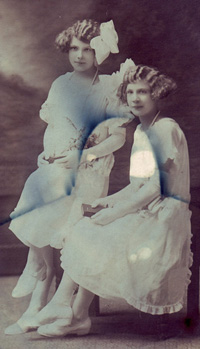
When I visited an elderly cousin in Chicago a few years ago, she unlocked a treasure-trove of photos her grandmother (my great-grandmother) had collected. Since this was a branch of the family I knew nothing about (my father having quite successfully hidden it), most of the folks I encountered were unfamiliar to me.
Many remain unfamiliar to anyone else, alas. My great-grandmother was not as diligent about labeling photos as she might have been. Find out who's who was dependent on what my cousin remembered (which was sometimes nothing) as well as some photo-detective work on my part.
This photo in particular intrigued me so I scanned it without knowing anything about it. There's some damage to the photo but it was such a pretty shot I couldn't pass it by.
I assumed the girls were twins (we have a few in various branches of our Petersen families) and that this was a confirmation photo, usually the case when young teens are shown grasping a small bible-type book. The hairstyles suggest the early to mid-nineteen-twenties, as do the dresses.
There are a couple of good candidates: Louis Petersen's twins Agnes and Anna, born in 1914, or his brother Peter's girls Marge and Myrtle, born in 1911. That's close---it could be either set of young ladies. Then there's this, and we do know these folks.
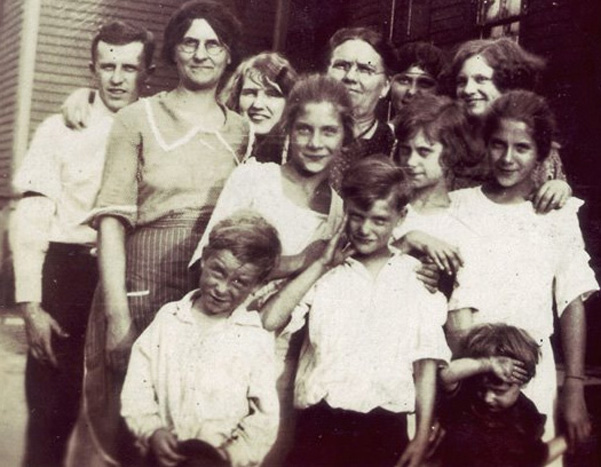
Peter's widow Martha is at left next to a young man whom we don't know, but the rest of the clan we do know. Their twin girls, Myrtle and Marge, are in the middle to right of the photo with sister Evelyn between them and brother Lawrence below.
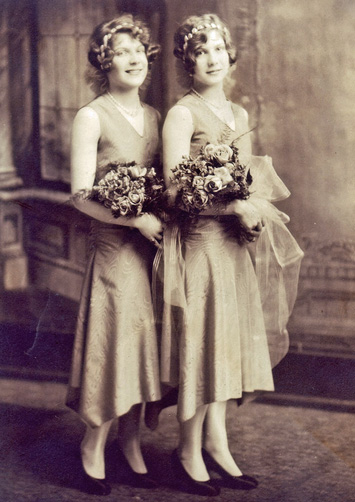
This doesn't help much. I think it was taken a bit later than the confirmation picture above, and because it's a family snapshot the girls don't have that slightly apprehensive look they have in the studio portrait. One of the girls, Myrtle, has a slightly more pug-like nose than her sister. That's the key to figuring out which girl is which.
Now in this photo of the ladies at their (assumed) high school graduation, which would have been about 1929, the mystery begins to clear. The lady on the right has that distinctive Myrtle nose. I think the girls in the first photo are definitely Marge and Myrtle. They would have been 12-14 years old in 1923-1925, so that fits the time frame for the damaged confirmation photo.
Am I right? It may be impossible to know for sure. But just recently I found a clue online to descendants of this family and sent off a friendly query to one cousin, who will either (perhaps) be able to enlighten me or (I hope not) run screaming in the opposite direction, fearing she's being stalked by some stranger who knows entirely too much about her family.
But that's my job, isn't it?
Show comments/Hide commentsComments
-
No comments yet.
Write A Comment
June 28, 2011: The waiting game
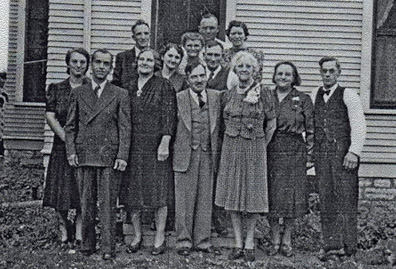
A year or so ago I found someone who had been searching online for information on someone from my family. Not surprising, it's happened before. But after contacting her I realized that she had an item of great value: a photo of someone we'd never seen.
Louis William Jatho was my grandmother's older brother. I knew he'd married a Martha Kruschke and settled in Wisconsin, but I didn't expect the Kruschke clan might have his picture when we did not. For some reason family pictures on my father's side of the family (back before 1930 or so) are few and far between. Possible reasons for this are painful to contemplate. I assume they existed once and were discarded by someone who didn't see any reason to keep them.
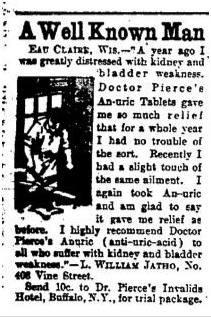
But tucked away in a family collection was the photo above of a Kruschke family reunion. They'd gathered on the occasion of the 50th birthday of Henry Kruschke, Martha's brother. At the right of the photo, in a white shirt and dark vest, is Louis Jatho; his wife Martha is just to the left. I had to wait for awhile to receive this remarkable image. My benefactor had to track it down in her own photo collection, then figure out how to scan it (her son came to the rescue), and attach it as email. It took a year but it was worth the wait.
We don't know a great deal about Louis. He was born in Charleston, moved with his widowed mother Jennie and siblings to Chicago in 1910, and worked initially as a switchman for the city railway. Later he and Martha moved to Eau Claire, Wisconsin, where he became a home decorator, specializing in painting and wallpapering.
The Eau Claire Leader in 1921 called him a well-known man, probably because of a fan letter he wrote about a miracle cure for kidney problems. Poor Louis probably didn't realize that his words would be made immortal via the marvels of advertising. For the next few years he waxed rhapsodic about Dr. Pierce's tablets in newspapers all over Wisconsin. I'm not sure whether he increased sales for the company, but I hope they gave him some extra samples by way of compensation.
The advertisement is genealogically useful, at least. It gives his actual address in Eau Claire, and it shows us how he probably signed his name: L. William Jatho. The Kruschke family knew him as Louis, though, so this might have been his everyday name.
Louis lived with Martha in St. Paul, Minnesota in his later years, where he died in 1956. Martha died in 1962. It's a delight to finally see what they look like.
Show comments/Hide commentsJune 15, 2011: Forward into the past
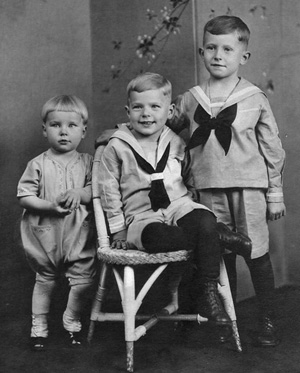
Finding living cousins can be more problematical than locating ancestral ones. But I'd like to find the children of these little guys.
They're the three Hoffmann boys, left to right Albert, John, and Charles. Their mother was the former Elizabeth Petersen, married in Omaha to Charles Hoffmann of Germany. Albert was a family favorite, apparently, and his proud grandfather Alfred Petersen exchanged photos with his own sister Catherine Petersen Mikkelsen in Chicago. That's how they came into my hands.
Albert died only recently in 2005 in Baltimore. Searches have unearthed no available obituaries for him so I don't know whether he himself had children. All I know is that somewhere there should be a passel of Hoffmanns who don't know about their Danish side. Could be they don't care. Not every family likes having a voluminous family history dropped ceremoniously in their lap.
But perhaps, if I pursue it, I'll get lucky. Just one chatty obituary in a local paper could tell me whom to contact. Having lost---and then found---my own family history, I'd hate for anyone to go without if they're truly curious and hoping they too will be lucky one day.
Show comments/Hide commentsComments
-
No comments yet.
Write A Comment
June 2, 2011: Fantasy and genealogy don't mix

All of us have been told stories about our background that turned out not to be quite right. The lady at right is Caroline Laurent Müller, born in Zweibrücken, Pfalz in 1822, later married to Louis Müller, a pastor in Charleston, South Carolina. A formidable and saintly presence (so we were told by relatives who remember her), one did not cross or contradict her.
One legend passed down with great tenacity and fervor was the name of her mother, Helena de Vigny, born into a noble family (so it was said), who was a child during the French revolution and was smuggled to the countryside in a barrel, which was placed in a horse-cart and covered with straw. Thus did the lass escape harm and grow up to give birth to Caroline.
Of course once I rented microfilm and discovered Caroline's baptism record, I realized that there was a misapprehension in the family legend. Caroline's mother was Philippina Jungblut, an unmarried laundress, and a local bookbinder, Philipp Laurent, was the acknowledged father.
When I brought this to the attention of the cousin who told me the tale, he was undaunted. Helena de Vigny must have been an earlier ancestor, he insisted, probably in the era of the Huguenots during their expulsion from France. Never mind that there's no paperwork to indicate the existence of Helena. Better to find an alternate (as well as chaotic) historical period where she could reside in legendary splendor.
I admit it baffles me when perfectly good documents are ignored in favor of fantasy---and there's no other way to describe Helena. Too many details of the narrow escape, not enough hard facts about her birth, marriage, death...in fact, no facts at all. But my cousin loves his own story, and I have to admit it's certainly more colorful than the alternative.
A similar circumstance is in the works with a different cousin from a different line. Granted, he'd believed this for the last forty years so it's hard to let go. While in the military he happened to be stationed in Hamburg, Germany and perused the phone book for his own surname. He found some similar names, called them and hoped they could speak English. Success! One fellow spun a tale of a man who had sent his son to America to look for a place to settle. The son never came back--that must be your ancestor, my cousin was told. And he believed it up until the time I contacted him, having traced him down via census and church records.
Or maybe he still believes it. I have a firm paper trail back from my cousin's father to his grandfather and great-grandfather. The latter was my own great-grandfather's brother. It all checks out, all of it's official, but apparently my cousin is still not convinced 100%.
Not sure what to do at this point, but I sympathize, having been led down the garden path about my own heritage for a number of years. Maybe someone should invest in support groups for family historians who discover the unexpected!
Show comments/Hide commentsComments
-
Personally I like keeping fake family stories in the history but distinguished from the real story. That way people will know all the tal tales!
Write A Comment
May 19, 2011: The face of the past
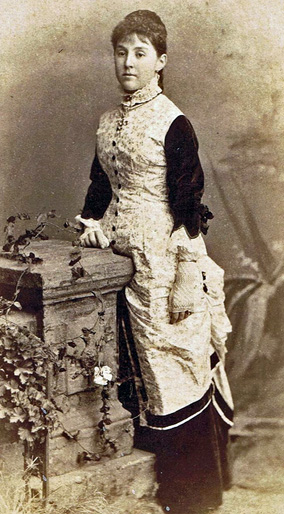
At a recent family reunion, a cousin asked casually whether I was still doing any research or was I "done". It's safe to say, I think, that no one is ever really done with family history. It's more a matter of juggling! Which family line will be the lucky one today?
Similarly, no one every hits the real bottom of the barrel when it comes to old photos. There's bound to be a hidden cache of pictures or a forgotten folder somewhere. If you're lucky enough to find such a thing (or to be on the receiving end of it), a windfall like this can provide an unexpected source of new information.
A cousin of mine discovered the stunning photo of an ancestor in a pile of old papers and forwarded it to me (now that he knows I have a taste for such things). It's Elise Clara Margaretha Jatho, born in 1862 during what had to be a precarious time in Charleston, South Carolina during the Civil War.
When this photo was taken around 1880, Elise's father had been dead for ten years. Her older brothers were keeping the family solvent. None were yet married and the family lived together on Hasel Street in town. Perhaps this was an engagement portrait. Elise wears a ring on her left hand and is decked out in the latest fashion.
Alas, she wouldn't live long enough to be married. Elise died in 1881 of typhoid fever. But her image has been rescued from oblivion, thanks to our cousin who paid attention to what was in that particular stack of papers. We've seen Elise's grave in Charleston, with its marble pillar of roses and lilies of the valley, and somber quote from Byron. But now we can see how lovely she really was, and it's somehow easier to imagine how acutely her family missed her.
Sometimes we're fortunate in this way, sometimes not. Another cousin in Florida---the first family historian, actually, whose work made my life a lot easier---died before her husband did. Upon her death he gathered up her notes and photos and blithely tossed them in the trash, muttering to those who were shocked to hear about it afterwards, "Now I won't have to put up with the past anymore".
For some folks, the past is a burden. I recognize that this is some folk's reality, but I sure don't understand it.
Show comments/Hide commentsComments
-
No comments yet.
Write A Comment
May 7, 2011: Dressel mystery solved!
Sometimes an idle Google search turns up an unexpected genealogical treasure.
Several weeks ago I was musing about the way some Dressel siblings in Charleston (whose father's first name was Hermann---one clue we knew) kept orbiting around my Jatho and Schuckmann folks from Charleston (see below for details). The nature of their interactions suggested a relationship of some kind, but what, exactly? Church books in Hesse-Darmstadt, their mutual area of origin, were not being particularly helpful.
I had a hunch I was on the cusp of a discovery, I just didn't know whence it would come.
Despite the fact that Google's search parameters are sometimes too wide to turn up such details, there are ways you can narrow down that focus. One is to choose a specific database (web, images, blogs, groups, etc.) and search only that particular area. I'd actually done this before, but not with Google Books. Their Books selections include publications that have gone out of copyright, and Google is uploading new material all the time.So one recent Saturday I noticed that a quick search within Books brought up some nifty new things, or new to me at least. Maybe it was the way I was searching, pairing up one of my surnames with a locale. To my delight, "Jatho Charleston" brought up some good online directories of Charleston (some not available via ancestry.com).
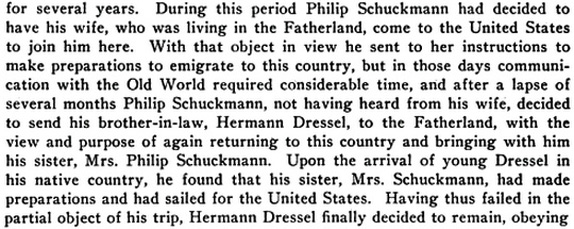
As for "Schuckmann Charleston"...well, that resulted in something very interesting indeed.
Philip was my great-great-great-grandmother Marie Dressel Schuckmann's son...and here's a brother---Hermann, just the man I need!
So what's this book? And does it reveal any more gems? It does:
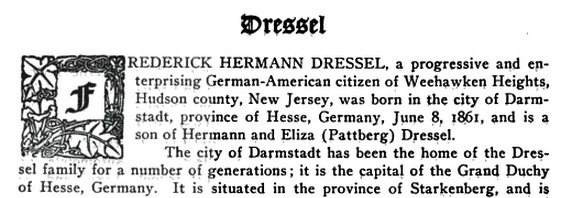
There are moments in any researcher's life when it's okay to shout a hearty huzzah (or the equivalent expostulation). So I did. Here was the constellation I needed---parents Hermann Dressel and Elisabeth Pattberg, a son called Frederick (previously unknown to me) and Hermann Dressel's relationship to Philip Schuckmann in Charleston.
The book? Carl Wilhelm Schlegel's "American Families of German Ancestry in the United States", published in 1918. Schlegel focused on a number of German surnames and sought out the most accomplished of that clan. And it's entirely free to read on Google Books.
It seems clear from reading it that some of the information came from interviews with family members themselves, so details may be at variance with what church books and census records tell us. For instance, Mr. Schlegel described Philip as Hermann's brother-in-law, a mistake or a misremembered fact from Frederick and his family. Philip was Marie's son, not husband, so Hermann was Philip's uncle. Louis Schuckmann was Marie's husband and thus Hermann's brother-in-law. But people forget things. That's why we look up the records ourselves, in the spirit of verification.
Google has a partial agreement to display pages from Mr. Schlegel's tome, meaning that not all pages are available online. As luck would have it, page 390, where the author described Frederick Dressel's detailed ancestry, was missing. But wonder of wonders, the Los Angeles Central Library had it complete, albeit a non-circulating copy of the book. A few hours after phoning them I was on my way, photocopied the pages in question, and now have Mr. Schegel's version of the Dressel history, which helpfully augments mine.
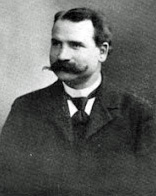
Another Google book offering gave me Frederick Dressel's picture...will wonders never cease!
Frederick Dressel, pictured at right, was the brother of my Charleston Mystery Dressels, which Mr. Schlegel's book confirms. Mr. Schlegel provided the names of the seven Dressel offspring who survived to adulthood, including George, Philip, and Elisabeth, whom we know from Charleston. Mr. Schlegel correctly names Elisabeth's husband as well, further verifying the connection.
And it turns out that Frederick was a well-respected botanist and orchid collector. His expertise was honed in Europe before coming to New Jersey and establishing himself and his business there.
Frederick's offspring and grandchildren are traceable through census and social security records. In fact, Frederick's great-grandchildren are named in a recent obit for his grandson Fred. I wonder how interested they'd be in a letter out of the blue from a very distant cousin?
Show comments/Hide commentsComments
-
No comments yet.
Write A Comment
April 28, 2011: In search of Jathos
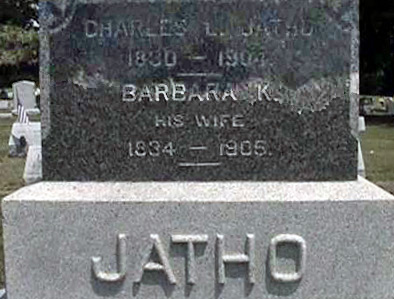
I guess mysteries are part of genealogy, and sometimes they stay that way.
This is the Seneca County, Ohio grave marker for Charles L. Jatho and his wife Barbara (much obliged to Linda Hickman for the image).
Charles shares a surname with my Jatho clan of Charleston, and from the 1900 census it looks like he shares the birth month and year for my ancestor's half-brother: June 1830. A tempting theory is that he and his half-brother George William both emigrated to the USA.
Carl Ludwig Jatho (if this is indeed the right fellow) reports that he emigrated in 1840---a bit of a stretch since no other Jathos from this clan emigrated to the USA that year and there's no record of his passage. In the 1860 census, however, Charles lived in Brooklyn and was a cigar maker. We presume he married Barbara there because their first child, William, was born in New York. By 1870 however the family had relocated to Tiffin, in Seneca County OH, and they had a daughter too, Katherine, born in February 1867.
Ordering the death records from the kind folks at Seneca County Probate Court didn't result in the right birthdate, alas. The handwritten record for 1904 says that Carl/Charles was born in September 1830, not June as he had reported in 1900. And for place of birth the record is left blank, though Charles reported in the 1870 census that he was from Hesse-Cassel...exactly where my Carl L. Jatho was supposed to be from.
No way to prove this any further, alas. Their children William and Katherine never married, so no DNA testing can be done. William and Kate's death records are online, but William reports his father was born in Frankfort, throwing one more spanner in the works.
A search of Ohio obituaries turned up the slightly macabre news item in the Sandusky Star (February 8, 1904), reporting that the horse-drawn hearse bringing Charles Jatho's casket to his home for the funeral had an altercation with a snowbank. The hearse overturned and the casket was sent through its glass panels, but "no one was hurt", the Star concluded...only poor departed Charles' final shred of dignity, I guess.
Show comments/Hide commentsComments
-
No comments yet.
Write A Comment
April 20, 2011: The Dressels of Mystery
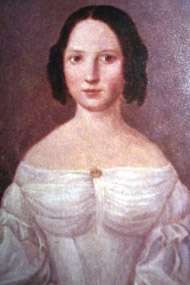
In my past are a series of folks called Dressel from Hesse-Darmstadt. There's not particular reason why I should be so fixated on finding them any more than some of my other local surnames from the region. Maybe it's the pretty picture of Anne Marie Dressel that does it.
Marie, as she was known, was the daughter of a master-butcher (an almost academic post, a fellow qualified to teach other butchers) in Bessüngen, Hesse-Darmstadt. Her father was sufficiently well-off to have her portrait painted about 1827, when she was sixteen. I doubt I'll ever have a chance to see any earlier images of one of my ancestors. The rest of them waited for photography, probably out of economic necessity.
Marie married reasonably well to Louis Schuchmann, had two children, and the family moved to Charleston, South Carolina to run a clothing and fabric store. Marie was particularly well known as a seamstress and made flags for the local militia.
Around the end of the 1870s some Dressel folks start showing up in the Charleston directories, church records, and censuses, but they're at least a generation (and a long one at that) younger than Marie, maybe two generations younger.
But they're connected to her in some way. One lodges with her widowed daughter Elise Jatho and Jatho grandchildren. Another joins her church, the venerable St. Matthew's German Lutheran congregation. The boys, Philip and George, are noted as witnesses to weddings of their Dressel/Schuchmann/Jatho cousins. One of them runs a business, Dressel & Jatho, an insurance brokering firm in Charleston. Their surnames mix in alluringly intimate ways. So who are these guys?
They have a sister too, Elizabeth, who emigrated in 1888 and married an August Sibberns in Charleston. Her death certificate gave the briefest of clues: her father was a Hermann Dressel. That's a start, anyway. But who was he?
Microfilm of Hesse-Darmstadt civil records is plentiful but confusing. I can find the older generation, I can find weddings. But no microfilm of the region seems to show these kids being born there. In fact, I can't find any Dressel births after 1842.
A few weeks ago I was fiddling with the IGI (International Genealogical Database) at the LDS site, which---if used judiciously---can turn up a clue or two. The extracted records do not have entries for a birth for George (1857, probably Johann Georg); Philip (1859, whose full name was Johann Georg Friedrich Philip), or Elizabeth (1867).
So I decided to search for a father called Johann Philipp Dressel and a mother Elisabetha Mass---these were Marie Dressel's parents. Nothing new, alas, just Marie (born in 1811) and her brother Johann Georg (born in 1813). But I already have them in my collection.
What about a search for parents called Philipp Dressel and Elisabetha Mass?
That did it. They had a son in 1822: Friedrich Hermann Ferdinand Dressel. Could this be the father called Hermann who was listed on Elizabeth Sibberns' 1947 Charleston death certificate?
Hermann Dressel married Elisabeth Pattberg in the Stadtpfarrei evangelical parish of Darmstadt in 1853. But so far not a trace of any children in birth records for the region from 1853 till 1867. Perhaps they had children in secret.
I just ordered new film of records for Bessüngen, Darmstadt. Maybe, with any luck, George, Philip and Elizabeth will show up there and I'll be able to prove them cousins of their Charleston kin. We shall see.
In the meantime, if you haven't had enough of the Dressels, check out their web site.
Show comments/Hide commentsComments
-
No comments yet.
Write A Comment
April 22, 2011: Lost and found
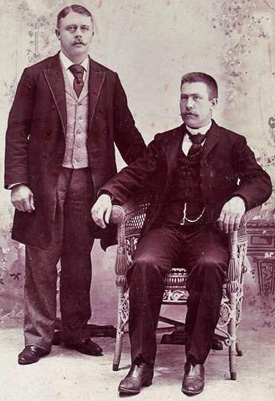
Among my many Petersens are twin sons of Peter H. and Elise Momsen Petersen. These are not the twins in the photo at left. The seated, stern-looking fellow came to the USA as Peter Edlef Petersen, renamed Alfred once he settled into farming in Nebraska.
The fellow standing is, I believe, Louis, twin of Andrew (see the post below). When part of the family left for Chicago around 1889, Alfred and Louis remained in the Omaha area. Alfred has a robust presence in the census so he's been easy to track. The problem boy was Louis. No matter how I searched for Louis Peters*n (wildcards are our friends) I could never find a definitive candidate in any census.
A recently-available database via ancestry.com solved the mystery of his whereabouts. His nephew Walter Petersen spent some time in Omaha, learning how to be a bartender and possibly involved in a short marriage. But he also applied for a passport in 1913 and the address where he wanted his passport sent was 3601 North 16th Street in Omaha. I thought that address might be handy at some point.
It was. I decided to do a quick search in the 1910 census, leaving out the first name, for a Peters*n living in Nebraska, born around 1867 in Germany (as Schleswig-Holstein was categorized then). Up popped a "Lony" Petersen (which, in the image file, was really "Louy"), born at the right time and place. His address? 3601 North 16th.
Louis was a saloonkeeper, Walter obviously his employee, so it all fit together neatly. After about 1916 Walter returned to Kenosha WI to be closer to his parents and family but Louis, married to a Swedish lady called Marie and with a daughter called Elizabeth, shows up again in the 1920 census, this time a confectionary retailer (Prohibition compelled Louis to seek a new trade, apparently). He doesn't show up in the 1930 census, but at least we've located him now. Without the passport database Louis would still be languishing in obscurity.
Show comments/Hide commentsComments
-
No comments yet.
Write A Comment
April 15, 2011: A new branch
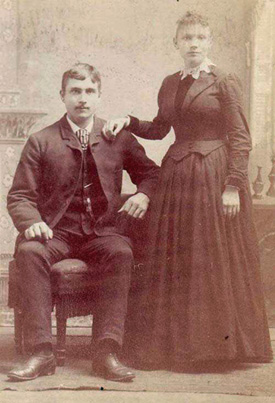
Last week was one of the fortunate ones for me. I found a new cousin. Okay, we're third cousins, which to some folks is barely being related, but for this particular branch of the tree was like finding someone who speaks my language. His great-grandfather and my great-grandmother were brother and sister. His was a branch that had been out of touch with our branch since (probably) the 1920s.
I owe this to a Rootsweb feature that I didn't know existed until I stumbled upon it---you can add a virtual post-it to a record in their death records database. My cousin left a post-it in 2002 and mentioned the fellow I was looking for---Loren Petersen, born in Wisconsin and died in California---and all Loren's siblings. I knew these siblings from the 1910 Kenosha census so I knew this was the right track.
Tracking down my cousin was yet a different matter. He'd posted with a Hotmail account...my heart sank when I saw it. Those are the first to go dormant when folks find a preferred email situation. Sure enough, mail to that account bounced.
So I did a web search on the email address. That turned up only one hit, to a high school alumni web page in Kenosha...where he was listed with the same broken email address. Couldn't think how to proceed until a friend suggested signing in to the alumni message board and leaving a message there.
It worked! Within half a day the webmaster had sent out my query to the entire high school mail list, where several of my cousins family members saw it, and forwarded my contact info to him.
He had never before seen a photo of his Petersen great-grandparents Andrew and Marie, which I was happy to share with him...as well as a page devoted to his great-grandfather's history, as best as I could reconstruct it.
Show comments/Hide commentsComments
-
No comments yet.
Write A Comment
April 9, 2011: A fork in the road

Sometimes genealogical information lurks in the china and silverware cabinet...literally.
We were visiting some cousins on the east coast recently. They have a treasure-trove of material involving our Charleston SC ancestors, most of it unrealized or things they'd forgotten about.
Before our arrival my cousin pulled out some unmatching forks and spoons from their silverware drawer, plus a few stray Limoges plates of an unassuming pattern, and casually mentioned to me that he'd never noticed any significance to the monograms on the silverware till now.
But it was obvious all of a sudden. The monograms related to our Charleston ancestors. By looking at the pattern of monograms (single letter or multiple) we could tell whether the silverware was meant for the generic family table or specifically for one of the daughter's trousseau.
Even the plates had a history. By examining the backstamp on the dishes we could date them to a four-year period in the late 1870s, which gave us a good clue which of our ancestors used them on her table.
Show comments/Hide commentsComments
-
No comments yet.
Write A Comment
April 2, 2011: Please, Mr. Postman

I ran across a Usenet post today from a fellow responding to a thread about how long to wait for a return note from a potential relative. He said he receives queries from cousins, gets distracted easily and sometimes sets aside a letter for years. Years, mind you.
I can understand a month or two, but years?
In my family it's not as if we've all kept in close touch. In some cases I email second and third cousins more often than my first cousins. And of the firsts, I haven't seen any of them in over thirty years. Some first cousins I've never even met.
It's not entirely my family's fault. My paternal grandparents' four children settled in a widely-scattered pattern throughout the USA, and during the time we were growing up none of them were wealthy enough for plane fare so we knew each other mostly by holiday cards.
But there was sufficient mystery about the family background that we often didn't know about more distant relatives. It remains to be seen whether this was an innocent lapse or deliberate disinformation. But it means I have tons of cousins who don't know me...and who don't know we're related.
Found a possible one in Florida the other week. She'd been posting about her New York ancestors online as recently as 2002, and after that...silence. But she'd left enough of a trail for me to realize that we're fourth cousins from a family called Laurent, originally from Zweibrücken, Pfalz.
I tracked her down to a probable address in Ft. Myers, wrote a polite note. Heard nothing. What to think? She's not related but can't pick up a pen (or send me an email) to tell me so? She's become disenchanted with the hobby? Or some other reason for the resounding silence?
Understanding now how some folks set aside mail for "years" leads me to believe I'll just have to be more patient. Maybe, as the fellow suggested, I should include a handy-dandy response postcard in every envelope I send from now on....
Show comments/Hide commentsMarch 29, 2011: How to ask
I wish I'd known how to ask genealogical questions when I was five years old. It might have gotten me further a lot faster. On the other hand -- perhaps considering parental reserve on the subject -- it might not have been much help.
Instead of asking for facts, names, dates, I think I should have been asking for memories, impressions, that sort of thing. Not "What was your grandmother's name" but rather "What do you remember about your grandmother?" "Was she nice?" "Did she like cats?" "Could she speak any languages?"
I might have gotten further with questions like those.
In fact, it might not be such a bad idea to write a little book about how to ask. Maybe there should be a version for kids (who could read it and use the techniques to delay their bedtime) as well as for adults, who might encounter resistance (for whatever reason) using the standard line of questioning.
There are some folks, too, who get suspicious of sharing too many details. This is an age of identity theft, after all. And it's worth reminding yourself that not everyone shares the genealogy obsession. Some folks might think you're crazy for pursuing the hobby with a zeal akin to mining for gold.
And such a book would have to bear a delicate title. Not something like "How To Get Those Pesky Genealogical Questions Answered Before Everyone Around You Dies". Something a bit more marketable. "Genealogical Queries for Dummies", perhaps?
Show comments/Hide commentsComments
-
No comments yet.
Write A Comment
March 20, 2011: What's in a name?
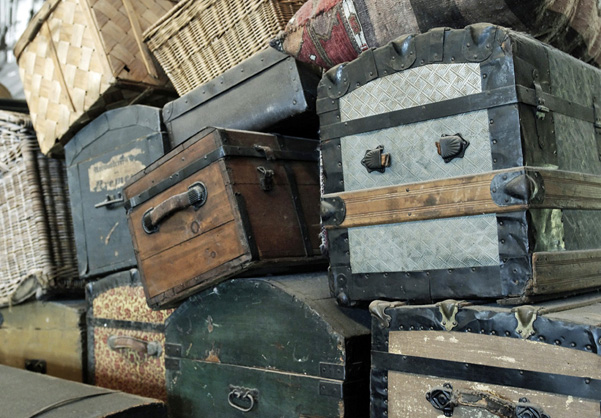
Everyone's named after someone, aren't they? It felt that way at one time. All my friends were named after grandmothers or great-aunts or some looming legend in their family background. Why not me?
When I asked, my parents said that they just liked the sound of my name, so they gave it to me. "Liked the sound of my name"... what sense did that make? How were ancestors to be ackowledged with a system like that? Who were my ancestors, anyway?
Maybe that was the problem right there.
These were burning concerns when I was about five or so. I figured I must have been adopted because I could get so little information out of my parents. When I asked about my grandfather's parents there was a ripple of discomfort in the air. They didn't know, exactly. What--no names, cities, anything?
Well, there was a great-grandmother about whom they knew next to nothing, didn't know her first name or her last name, just knew that she kept getting married all the time.
This was disconcerting. How many times? They weren't sure, her husbands just kept dying. I had a vision of someone akin to Lady Macbeth, ruthless and amoral, some shadowy merry widow with her eye on the next culprit. For awhile, so they said, she was married my great-grandfather. But they didn't seem to know his first name either.
Their cavalier approach to family history bothered me mightily, but at age five I wasn't in much of a circumstance to do anything about it. You tend to accept what your parents tell you about family, maybe not about politics or religion or how much candy is good for you or whether comic books will ruin your mind or whether "sputnik" is an English or Russian word--you have some backbone after all. But why would they mislead their own child about something so elemental as a surname?
I confess I still don't know. But they did, I think, or at least one of them did. Maybe for innocent reasons (She Doesn't Need To Know That), maybe because of a painful childhood with a dysfunctional (on some level) family, perhaps even due to baggage from further back in the past.
But baggage always calls out to be opened, doesn't it?
Show comments/Hide commentsComments
-
No comments yet.
No comments yet.